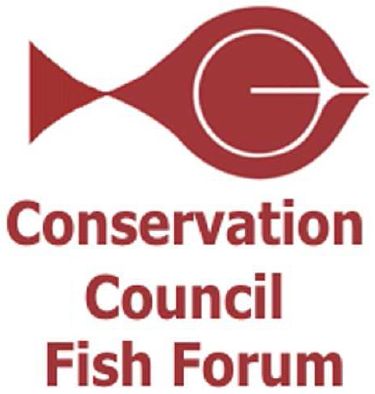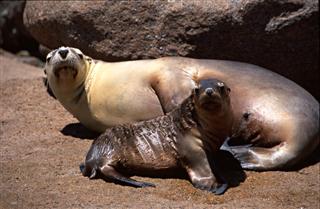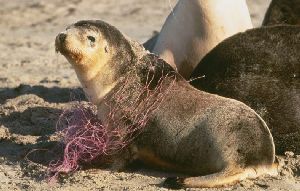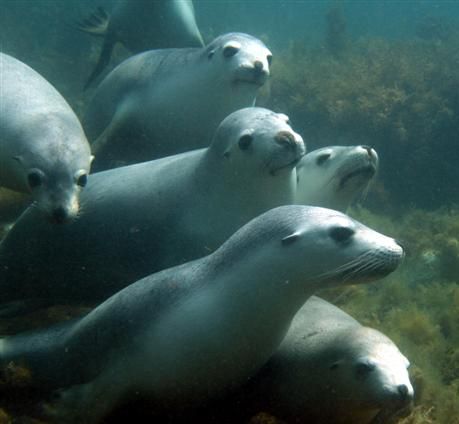| Fish Forum |
| Home |
 |
Australian sea lions remain under threat
The second CCSA Fish Forum (Wednesday, 4th February 2009) focused on the Australian sea lion (see minutes). .
 |
The
Australian sea lion (ASL) is endemic to southern Australia, with 85% of
the population found in SA (the rest are in WA). There are 38 sub-populations
in SA, many of which are genetically distinct, despite the close proximity
of some of them. Although there are some relatively large sub-populations
(e.g. Dangerous Reef, The Pages and Seal Bay), 60% of the sub-populations
produce less than 30 pups during each breeding cycle (approximately 18
months).
Many of these sub-populations are in decline, and the status of this species has been upgraded to:
- Endangered
on the IUCN 2008 Red List of Threatened Species (in 2008)
- Vulnerable
under the Environment Protection and Biodiversity Conservation Act
1999 (in 2005)
- Vulnerable under the South Australian National Parks and Wildlife Act 1972 (in 2008)
However, the recovery plan (under the EPBC 1999 Act) has not yet been produced.
 The
major threat to this species is likely to be gillnetting by the Commonwealth
Southern and Eastern Scalefish and Shark Fishery (SESSF), and to a limited
extent by the SA Marine Scalefish fishery. Fishing effort is substantial
in SA and adjacent waters, with 20,000 km of net set per year (enough
to cover the width of SA waters ten times over or go half the way around
the world). There is an almost complete overlap between this fishing effort
and ASL foraging areas, and fishing occurs in close proximity to most
subpopulations (see Goldsworthy
et al. 2007a; Goldsworthy & Page 2007).
The
major threat to this species is likely to be gillnetting by the Commonwealth
Southern and Eastern Scalefish and Shark Fishery (SESSF), and to a limited
extent by the SA Marine Scalefish fishery. Fishing effort is substantial
in SA and adjacent waters, with 20,000 km of net set per year (enough
to cover the width of SA waters ten times over or go half the way around
the world). There is an almost complete overlap between this fishing effort
and ASL foraging areas, and fishing occurs in close proximity to most
subpopulations (see Goldsworthy
et al. 2007a; Goldsworthy & Page 2007).
Although a review of fishery logbooks from 1999-2004 showed only seven seal mortalities (species unknown), results from a recent observer program show an ASL by-catch rate of 0.015/km of net set (see Agenda Paper 5, item 5.5, attachment B, of the Gillnet, Hook and Trap Management Advisory Committee meeting, April 2008). This equates to 300 Australian sea lions per year. Population viability analysis shows that seven sub-populations would be driven to virtual extinction with this level of bycatch, and iconic populations at Seal Bay and The Pages would be close behind them (see Goldsworthy et al. 2007a; Goldsworthy & Page 2007).
Spatial closures are needed to mitigate such fishery impacts, and this view is supported by the dramatic recovery of the Dangerous Reef sub-population following the closure of this area to gillnetting (see Goldsworthy et al. 2007a, Figure 5.3). Based on reported catch history, a spatial closure around the area containing the seven most at-risk ASL populations (Nuyts Archipelago) would remove only 5% of fishing effort (see Goldsworthy & Page 2007).
|
The SESSF successfully retained its accreditation as an ecologically sustainable Wildlife Trade Operation in December 2006 (see assessment details). However, the Humane Society International brought a legal challenge against this decision, because of the detrimental impact on a number of threatened species including the Australian sea lion. After months of negotiations, a settlement was reached binding the Australian Fisheries Management Authority (AFMA), after considering advice from relevant experts, to develop and implement management measures, including fishery closures, that take account of site specific issues and which seek to minimise the risks of interaction between fisheries regulated by AFMA and sea lions by 21 December 2009.
 Within
South Australia, more could be done to support research and management
for the ASL, which are one of the premier tourism attractions in SA and
an iconic species for divers and snorkellors. Despite Australian sea lions
being part of a multimillion dollar tourism industry with a focus on Seal
Bay with more than 100,000 visitors each year, and large recent increases
in entry fees, not one dollar from these entry fees is being used to monitor
the sea lion populations and ensure that their numbers are recovering
and that they are being managed sustainably.
Within
South Australia, more could be done to support research and management
for the ASL, which are one of the premier tourism attractions in SA and
an iconic species for divers and snorkellors. Despite Australian sea lions
being part of a multimillion dollar tourism industry with a focus on Seal
Bay with more than 100,000 visitors each year, and large recent increases
in entry fees, not one dollar from these entry fees is being used to monitor
the sea lion populations and ensure that their numbers are recovering
and that they are being managed sustainably.
Seal Bay should be the focus for the educating the public about threats to sea lions. Tourists would expect that a portion of the entry fee paid would be directed towards ensuring these special animals can be enjoyed by future generations (as happens for other Australian natural wonders such as the Phillip Island Penguins or the Great Barrier Reef). Instead, this endangered species is being exploited for economic gain while the population declines.
All the signs suggest that the Seal Bay Australian sea lion population has been in decline for more than 25 years, with its population expected to halve within 30 years (Goldsworthy et al. 2008). Ongoing monitoring (with long time series) is required to confirm these trends. SARDI scientists have developed and costed a joint SARDI/DEH population monitoring and research program required to underpin sustainable tourism at Seal Bay (Goldsworthy et al. 2007b). The report identified that funding from a levy on visitor fees and tourism operator licence fees should be investigated because current sources of funding (mainly from competitive grants) are inadequate to meet the real costs of population monitoring and research.
A media release in 2008 from the Friends of Sceale Bay also called for better monitoring and called for contributions from the Eyre NRM Board and tourism ventures based on ASLs in the region.
References
Goldsworthy, S.D. and Page, B. 2007. A risk-assessment approach to evaluating the significance of seal bycatch in two Australian fisheries. Biological Conservation 139: 269-285.
Goldsworthy, Hamer & Page 2007. Assessment of the implications of interactions between fur seals and sea lions and the southern rock lobster and gillnet sector of the Southern and Eastern Scalefish and Shark Fishery (SESSF) in South Australia. SARDI Aquatic Sciences Publication Number F2007/000711-1. SARDI Research Report Series Number 225, pp 164.
Goldsworthy SD, McKenzie J, Shaughnessy PD, Macintosh RR, Page B, Campbell R, 2009. An Update of the Report: Understanding the Impediments to the Growth of Australian Sea Lion Populations. Report to the Department of the Environment, Water, Heritage and the Arts. SARDI Publication Number F2008/00847-1. SARDI Research Report series No. 356. 175pp.
Goldsworthy SD, Shaughnessy PD, McIntosh RR, Kennedy C, Simpson J, Page B 2008. Australian sea lion populations at Seal Bay and the Seal Slide (Kangaroo Island): continuation of the monitoring program. Report to the Department for Environment and Heritage, Wildlife Conservation Fund, SARDI Aquatic Sciences Publication Number F2008/000645-1, SARDI Research Report Series Number 293, 53 pp
Goldsworthy SD, Shaughnessy PD, McIntosh RR, Page B, 2007. A population monitoring and research program to assist management of the Australian sea lion population at Seal Bay Conservation Park, Kangaroo Island. Final Report to the South Australian Nature Foundation. SARDI Aquatic Sciences Publication Number F2007/000913-1, SARDI Research Report Series Number 241, 45 pp.
Shaugnessy & Goldsworthy 2007, Population assessment of fur seals and sea lions at some colonies in South Australia, 2006-07. Final Report to the Department for Environment and Heritage, South Australia and the South Australian Wildlife Conservation Fund, September 2007. SARDI Aquatic Sciences Publication Number F2007/000750-1. pp 43.